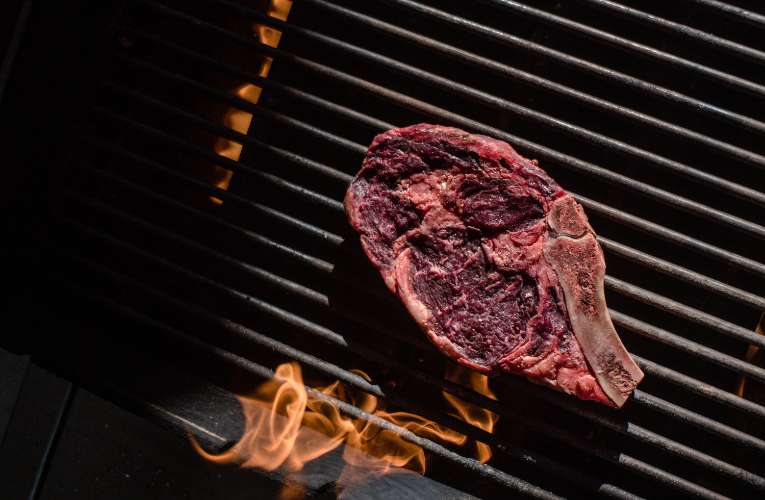Grilling dry-aged steak is a culinary delight that elevates the flavor and tenderness of the meat to new heights. The process of dry-aging enhances the natural flavors and textures, resulting in a deliciously rich and juicy steak.
In this guide, we will take you through the steps to achieve a perfectly grilled dry-aged steak, from selecting the right cut to mastering the grilling technique. Get ready to indulge in a mouthwatering steak experience like no other!
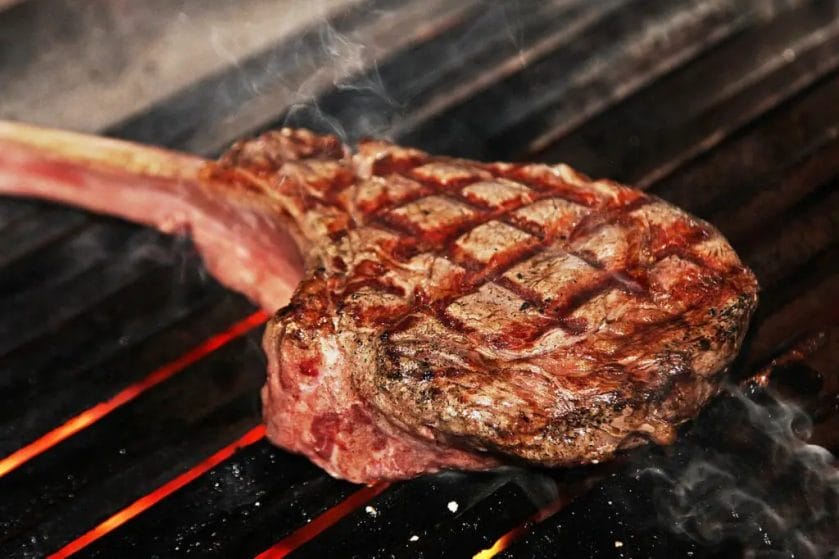
Selecting the Best Dry Aged Steak: Expert Tips and Recommendations
When it comes to indulging in a mouthwatering steak, nothing quite compares to the rich and intense flavor of a well-aged piece of meat. Dry aging is a traditional method of enhancing the tenderness and taste of beef, resulting in a truly exceptional dining experience.
However, with so many options available, selecting the best dry aged steak can be a daunting task. In this section, we will provide you with expert tips and recommendations to help you make an informed decision.
1. Quality of the Meat
The first and most important factor to consider when selecting a dry aged steak is the quality of the meat. Look for cuts that come from prime-grade or high-quality beef, as this will ensure a superior taste and texture.
The marbling, or the distribution of fat within the meat, is also crucial. Well-marbled steaks tend to be more tender and flavorful.
2. Source of the Beef
Knowing the source of the beef is essential for determining its quality. Look for steaks that come from reputable producers or suppliers known for their commitment to sustainable and ethical practices.
Locally sourced, grass-fed beef is often considered a top choice due to its superior flavor and higher nutritional value.
3. Aging Process
The length and method of the aging process greatly influence the flavor and tenderness of the steak. Dry aging involves hanging the meat in a controlled environment for a specific period, allowing natural enzymes to break down the muscle fibers and enhance the beef’s natural flavors.
The longer the aging process, the more intense the flavors will be. However, keep in mind that longer aging may also result in a higher price tag.
4. Appearance and Texture
Inspect the steak’s appearance and texture to ensure its quality. Look for a deep red color with a slight marbling of fat throughout the meat. The surface of the steak should have a dry, slightly crusty texture, indicating proper aging.
Avoid steaks that appear overly wet or have a slimy texture, as this may indicate spoilage.
5. Cut of the Steak
The specific cut of the steak should be chosen based on personal preference and cooking method. Different cuts, such as ribeye, T-bone, or New York strip, offer distinct flavors and tenderness levels.
Consider how you plan to cook the steak and choose a cut that complements your desired cooking style.
6. Recommendations from Experts
When in doubt, rely on the recommendations of experts or trusted sources. Professional chefs, butchers, and well-regarded culinary publications often have valuable insights on the best dry aged steaks available in the market.
Their recommendations can help guide you towards choosing a steak that is sure to impress.
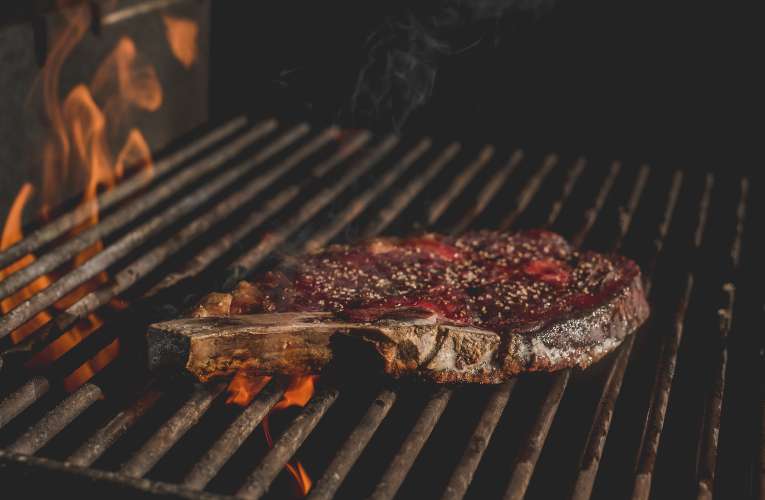
Preparing the Steak: Seasoning and Marinating Techniques for Grilled Dry Aged Steak
Grilled dry aged steak is a delicacy that requires careful preparation to bring out its rich flavors and tender texture. One of the most important steps in this process is seasoning and marinating the steak properly.
In this section, we will explore some techniques to enhance the taste and tenderness of your grilled dry aged steak.
1. Salt and Pepper Rub
The simplest and most classic way to season a dry aged steak is with a salt and pepper rub. This technique allows the natural flavors of the meat to shine through while adding a subtle seasoning. Start by patting the steak dry with paper towels to remove any excess moisture.
Then generously season both sides of the steak with kosher salt and freshly ground black pepper. Allow the steak to rest at room temperature for about 30 minutes before grilling to allow the seasoning to penetrate the meat.
2. Herb and Garlic Marinade
If you want to infuse your dry aged steak with additional flavors, a herb and garlic marinade can be a great option. Create a marinade by combining minced garlic, fresh herbs like rosemary and thyme, olive oil, and a splash of lemon juice.
Place the steak in a resealable plastic bag and pour the marinade over it. Seal the bag and refrigerate for at least 2 hours, or overnight for maximum flavor infusion. Before grilling, remove the steak from the marinade and blot off any excess moisture with paper towels.
3. Soy Sauce and Worcestershire Marinade
For an umami-rich flavor profile, try a soy sauce and Worcestershire marinade for your dry aged steak. In a bowl, whisk together soy sauce, Worcestershire sauce, minced garlic, and a touch of brown sugar.
Place the steak in a shallow dish and pour the marinade over it, ensuring that both sides are coated. Allow the steak to marinate in the refrigerator for at least 1 hour, or up to 4 hours. Before grilling, remove the steak from the marinade and let it come to room temperature.
4. Beer and Spice Marinade
If you prefer a bolder flavor profile, consider a beer and spice marinade for your dry aged steak. In a mixing bowl, combine your favorite beer, such as a stout or IPA, with spices like paprika, cumin, garlic powder, and onion powder.
Place the steak in a resealable plastic bag and pour the marinade over it. Seal the bag and refrigerate for at least 2 hours, or overnight. Before grilling, remove the steak from the marinade and pat it dry with paper towels.
5. Dry Rubs
Another option for seasoning your dry aged steak is to use a dry rub. Dry rubs are spice blends that create a flavorful crust on the exterior of the meat.
You can purchase pre-made dry rubs or create your own by combining spices like smoked paprika, chili powder, garlic powder, onion powder, and brown sugar. Generously apply the dry rub to both sides of the steak, pressing it into the meat to ensure even coverage.
Allow the steak to rest at room temperature for about 15 minutes before grilling.
Temperature Control
Temperature control is one of the most important factors when it comes to grilling a perfect dry-aged steak. It is crucial to have a consistent and accurate temperature throughout the cooking process. Here are some tips on temperature control:
- Preheat your grill: Before placing the steak on the grill, make sure to preheat it to the desired temperature. This will ensure that the steak cooks evenly and avoids any temperature fluctuations.
- Use a meat thermometer: Investing in a good quality meat thermometer is essential for grilling the perfect dry-aged steak. This will help you monitor the internal temperature of the steak and ensure it reaches the desired doneness.
- Indirect vs. direct heat: Depending on the thickness of the steak, you can choose between indirect and direct heat. For thicker cuts, it is recommended to use indirect heat to cook the steak evenly without overcooking the exterior.
Timing
Timing plays a crucial role in grilling a dry-aged steak to perfection. Here are some guidelines to help you determine the cooking time:
- Bring the steak to room temperature: Before grilling, allow the steak to sit at room temperature for about 30 minutes. This will help the steak cook more evenly.
- Cooking time per side: The cooking time per side will depend on the thickness of the steak and the desired level of doneness. As a general rule, for a medium-rare steak, cook each side for about 4-5 minutes. Adjust the cooking time accordingly for different levels of doneness.
- Resting time: After grilling, it is important to let the steak rest for a few minutes before slicing. This allows the juices to redistribute and results in a juicier steak.
Techniques
Using the right grilling techniques can make a significant difference in the outcome of your dry-aged steak. Here are some techniques to consider:
- Searing the steak: Searing the steak at high heat helps to create a flavorful crust on the exterior while keeping the interior juicy. Start by searing the steak for a couple of minutes on each side before reducing the heat.
- Grill marks: For those aesthetically pleasing grill marks, place the steak diagonally on the grill grates and rotate it halfway through the cooking process.
- Basting with marinade or butter: Basting the steak with a marinade or melted butter during the grilling process can add extra flavor and moisture to the steak.
- Using wood chips: Adding wood chips to your grill can enhance the flavor of your dry-aged steak. Different types of wood chips, such as hickory or mesquite, can impart unique smoky flavors.
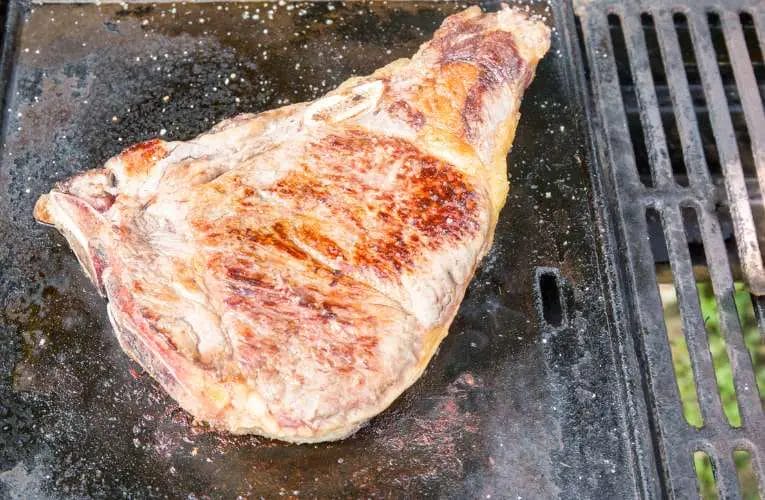
Sides and Sauces to Complement your Grilled Dry Aged Steak: Delicious Pairings and Recipes
When it comes to enjoying a perfectly grilled dry-aged steak, pairing it with the right sides and sauces can elevate the dining experience to a whole new level.
The right combination of flavors and textures can enhance the natural richness and tenderness of the steak, creating a symphony of taste sensations on your palate.
In this section, we will explore some mouthwatering side dishes and delectable sauces that perfectly complement a grilled dry-aged steak.
1. Classic Steakhouse Sides
There are certain sides that have become timeless classics in the world of steakhouses. These sides are known for their ability to enhance the flavor of the steak without overpowering it. Here are a few staple options:
- Creamed Spinach: This velvety side dish combines the richness of cream with the earthy flavor of spinach. It provides a creamy and slightly tangy contrast to the savory steak.
- Loaded Baked Potato: A traditional favorite, a loaded baked potato is the epitome of comfort food. The fluffy potato topped with cheese, bacon, and sour cream adds a satisfyingly indulgent element to the meal.
- Mushroom Gratin: Sautéed mushrooms baked with a crispy breadcrumb and cheese topping create a delightful umami flavor that complements the steak beautifully.
2. Fresh and Vibrant Sides
If you prefer lighter and fresher options to balance the richness of the steak, consider incorporating some fresh and vibrant sides into your meal:
- Grilled Asparagus: Tossed in olive oil, salt, and pepper, grilled asparagus brings a hint of smokiness and a satisfying crunch to the plate.
- Tomato and Mozzarella Salad: A refreshing salad made with juicy tomatoes, fresh mozzarella, basil leaves, and a drizzle of balsamic glaze. It adds a burst of freshness and acidity to the meal.
- Roasted Brussels Sprouts: Roasting Brussels sprouts brings out their natural sweetness and caramelizes the edges, creating a delightful balance of flavors when paired with the steak.
3. Decadent Steak Sauces
While a perfectly grilled dry-aged steak is delicious on its own, adding a flavorful sauce can take it to new heights. Here are some decadent steak sauces that will make your taste buds sing:
- Peppercorn Sauce: Made with crushed peppercorns, cream, and a touch of brandy, this sauce adds a bold and peppery kick to the steak.
- Béarnaise Sauce: A classic French sauce made with egg yolks, butter, and herbs like tarragon and chervil. It is rich, velvety, and adds a luxurious touch to the steak.
- Red Wine Reduction: A reduction of red wine, shallots, and beef stock creates a deep, robust sauce that complements the steak’s flavor profile.
Now that you have some ideas for sides and sauces to accompany your grilled dry-aged steak, it’s time to put them into action. Below are a few simple recipes to get you started:
Recipes:
Creamed Spinach
Ingredients:
- 1 pound fresh spinach
- 2 tablespoons butter
- 2 cloves garlic, minced
- 1 cup heavy cream
- 1/4 cup grated Parmesan cheese
- Salt and pepper to taste
Instructions:
- Wash and trim the spinach, removing any tough stems.
- In a large skillet, melt the butter over medium heat. Add the minced garlic and cook until fragrant.
- Add the spinach to the skillet and cook until wilted, stirring occasionally.
- Pour in the heavy cream and simmer for 5 minutes.
- Stir in the grated Parmesan cheese and season with salt and pepper.
- Remove from heat and serve hot with your grilled dry-aged steak.
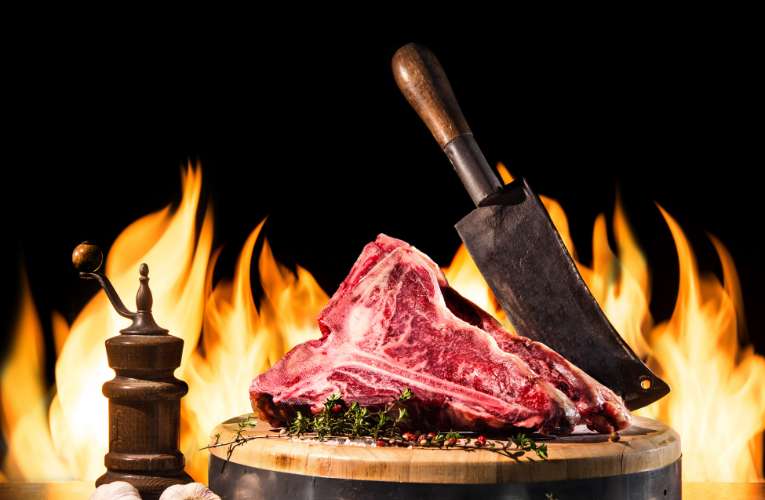
Expert Tips for Achieving Restaurant-Quality Grilled Dry Aged Steak at Home
Are you a steak lover who craves the deliciousness of a perfectly grilled dry aged steak, but can’t always make it to a fancy restaurant? Well, worry no more!
With a few expert tips and tricks, you can now achieve that restaurant-quality grilled dry aged steak right in the comfort of your own home. Here are some insider secrets to help you elevate your steak game and impress your family and friends.
1. Choose the Right Cut
When it comes to grilling steak, choosing the right cut is crucial. For that mouthwatering, melt-in-your-mouth experience, opt for dry aged steak.
Dry aging enhances the flavor and tenderness of the meat, resulting in a more intense and rich taste. Popular dry aged cuts include ribeye, T-bone, and porterhouse.
Make sure to purchase your steak from a reputable butcher who specializes in dry aging.
2. Prep and Season the Steak
Before grilling, it’s important to properly prep and season your steak. Start by allowing the steak to come to room temperature, as this promotes even cooking. Pat the steak dry with paper towels to remove any excess moisture.
Season the steak generously with kosher salt and freshly ground black pepper. You can also add your favorite dry rub or marinade for additional flavor. Let the seasoned steak sit for at least 30 minutes to allow the flavors to penetrate the meat.
3. Get the Grill Hot
One key to achieving that perfect crust on your steak is getting the grill hot. Preheat your grill to high heat, around 450-500°F (232-260°C). This high heat will create a nice sear on the steak, locking in the juices and creating those delicious grill marks.
Additionally, make sure to clean the grill grates thoroughly, as any residue can result in a less desirable taste.
4. Master the Grilling Technique
To cook your dry aged steak to perfection, it’s important to master the grilling technique. Start by searing the steak on high heat for a few minutes on each side. This initial sear will create a flavorful crust.
Then, move the steak to a slightly lower heat (medium-high) and continue cooking until it reaches your desired level of doneness. Use a meat thermometer to ensure accuracy. Remember to only flip the steak once during the cooking process to preserve its juiciness.
5. Rest and Slice
Once your steak is cooked to perfection, resist the urge to dig in right away. Resting the steak for about 5-10 minutes allows the juices to redistribute, resulting in a more flavorful and tender steak.
This resting period also prevents the steak from becoming dry. After resting, slice the steak against the grain to ensure maximum tenderness.
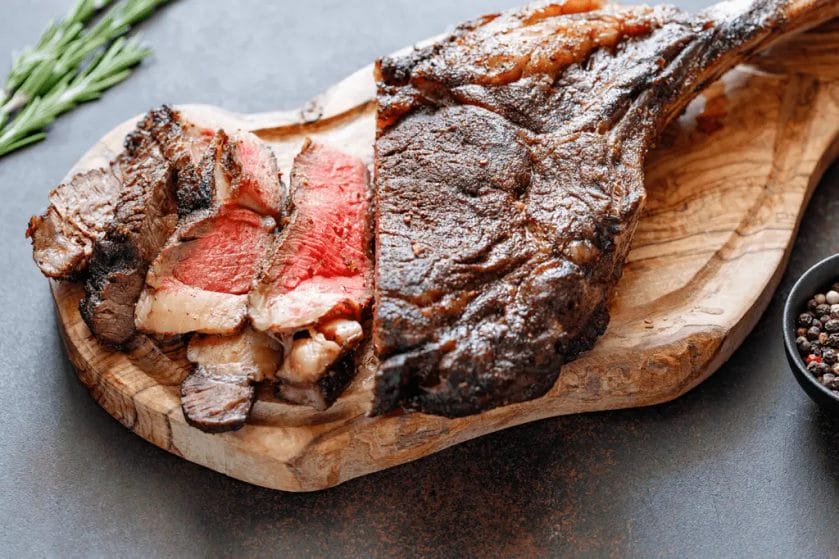
FAQs
How do I grill a dry aged steak?
To grill a dry aged steak, start by preheating your grill to high heat. Season the steak with salt and pepper, and brush it lightly with oil. Place the steak on the grill and cook it for about 5-6 minutes per side for medium-rare, or adjust the cooking time according to your desired doneness.
Use a meat thermometer to ensure it reaches an internal temperature of 130-135°F. Let the steak rest for a few minutes before slicing and serving.
Do I need to marinate a dry aged steak before grilling?
No, marinating a dry aged steak is not necessary. Dry aged steaks have already undergone a process that enhances their flavor and tenderness. Simply seasoning the steak with salt and pepper before grilling is enough to bring out its natural flavors.
Should I use direct or indirect heat when grilling a dry aged steak?
It’s recommended to use direct heat when grilling a dry aged steak. This means placing the steak directly over the heat source. Direct heat helps to sear the steak and develop a delicious crust on the outside, while keeping the inside juicy and tender.
Conclusion
In conclusion, learning how to grill dry aged steak can elevate your culinary skills and impress your guests with succulent and flavorful meat. By following the steps mentioned in this guide, you can achieve the perfect grilled dry aged steak every time.
Remember to start with a quality cut of dry aged steak, properly season it, and preheat your grill to the ideal temperature. Additionally, searing the steak on high heat and then finishing it over indirect heat will help create a delicious crust while ensuring the inside remains tender and juicy.
Don’t forget to let the steak rest before slicing and serving to allow the juices to redistribute, resulting in a truly exceptional dining experience.
With practice and attention to detail, you can become a master of grilling dry aged steak, impressing your family and friends with restaurant-quality dishes in the comfort of your own backyard.
So fire up the grill, grab your favorite dry aged steak, and get ready to indulge in a mouthwatering and unforgettable culinary experience. Happy grilling!

